SEJournal Online is the digital news magazine of the Society of Environmental Journalists. Learn more about SEJournal Online, including submission, subscription and advertising information.
 |
| Phragmites australis is the dominant plant of the Mesopotamian marshes. People build their houses, fences, animal pens, floor mats and more out of this fast-growing, renewable resource. Marsh dwellers spend a lot of time harvesting and processing the reeds. This woman is heading home at dusk with a full load of the reeds. Click to enlarge. Plus, see the full photo gallery of images. |
EJ InSight: Reporting from Iraq — with Both Camera and Notebook
EDITOR’S NOTE: In this issue, SEJournal launches a new quarterly section devoted to visual journalism — Environmental Journalism InSight. Edited by former SEJournal photo editor Roger Archibald, it will explore the whole range of photojournalism, videography, information graphics and data visualization, and how those specialties are combining more and more with traditional print reporting. Starting today with Erica Gies, contributors will share their experiences into how they’re adapting to the new concept of multimedia journalism, and provide valuable insights into helping us all do the same.
By Erica Gies
If you go to Iraq to report a story but take no photos, did it even happen?
Earlier this year, I got the unusual opportunity to visit that country to report on the efforts of a young woman working with a small NGO seeking to protect Persian leopards in Iraq, and establish, along with Iran, an international peace park to preserve their habitat.
My resulting story, “Patience, Peace and Persian Leopards,” was published recently on bioGraphic (and picked up by both the Atlantic and Discover), and was illustrated from a variety of sources: photos the editor obtained from a professional Iranian wildlife photographer, pictures more specific to the story taken by one of its subjects, one camera trap photo and two of my own.
But I knew that I wanted to share the experience beyond just publishing my story. Going to Iraq felt like a privilege, to see firsthand a place where not many foreigners go, and I felt compelled to show the world a side of the country they may not know: warm, friendly people; fascinating ancient cultures; gorgeous mountains populated by leopards, and surprising biodiversity — #everydayIraq.
Juggling camera, mic, notepad
While I’m primarily a print journalist, I’ve always enjoyed photography as a hobby. As our industry has foundered financially, I’ve felt driven to diversify my skills (even trying my hand at radio several years ago) to make me more valuable to editors and to pad my income a bit.
It's challenging to juggle a camera, microphone and notepad.
But pictures can tell a story that words can't convey.
I think they increase my value as a journalist.
It’s challenging to juggle a camera, microphone and notepad (in fact, I dropped and broke my camera doing just that on a recent reporting trip in San Francisco). But pictures can tell a part of the story that words can’t convey, and over the years, I’ve sold photos to many outlets. They don’t make up a significant part of my income, but I think they increase my value as a journalist.
Inspired by photographers like National Geographic’s Steve Winter, who writes longish posts about conservation to accompany his gorgeous photos of big cats on Instagram, I wrote little mini-stories from Iraq along with my pictures for my Instagram and FaceBook accounts.
But I was careful not to post them until I was back home so as to not tip off my location to anyone who might profit from my capture, or to risk border troubles, if I’d inadvertently posted something problematic to somebody.
Photography central to Persian leopard story
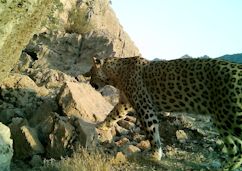 |
| A camera trap captured this shot of a male Persian leopard in Iraq, which was used to illustrate Gies' story in bioGraphic.com. Photo © Nature Iraq /German Consulate General/Goldman Environmental Foundation, 2017. Click to enlarge. |
Photography actually played a key role for my story’s main source.
Armed with just a bachelor’s degree in biology in 2010, Hana Raza partnered with the NGO Nature Iraq and wrote a grant for camera traps. Within four months of her setting them out, they revealed evidence of a Persian leopard in the wilds of the Zagros Mountains in Kurdistan, where people had thought the species was extirpated.
Now eight years later, Raza has still not actually seen a leopard in the flesh, but her cameras have continued to document leopards in the region. Through international grants to support her work, she’s developed plans for the leopard’s protection, persuading politicians in a male-dominated society to support her vision.
She’s now working to create an international peace park spanning Iraq and Iran to protect the leopard’s habitat.
My destination in Kurdistan was Slemani (or Sulaymaniyah, as Arab Iraqis call it), a clean, modern city that’s much less conservative than southern Iraq. It sits at the foothills of mountains that soar to 10,000 feet.
The Kurds I met had all experienced terrible things: chemical attacks; exodus to Iran on foot during childhood; witnessing people blown up by landmines; a father executed in prison.
Perhaps because of this, they come across as matter-of-fact realists, moving forward, getting on with life, despite the echoes of war all around them.
Mesopotamian marshes, fabled ‘cradle of civilization’
Being in Iraq was great, but getting there was a journey unto itself.
In a sense, my odyssey had started five years earlier, when I wrote an article for the New York Times (may require subscription) about Azzam Alwash, who had just received the Goldman Environmental Prize for his work to save the Mesopotamian marshes.
This fabled 'Cradle of Civilization’ between the Tigris and Euphrates rivers in southern Iraq was nearly destroyed by former Iraqi dictator Saddam Hussein.
Alwash invited me to come to Iraq to see the marshes, but after looking into the logistics and security, I decided it wasn’t safe enough and opted instead to interview him during a press stop in London.
But this year, when the same NGO, Nature Iraq, gave me the tip about Hana Raza’s Persian leopard conservation work in Kurdistan and encouraged me to visit, I looked again.
Various militias were still fighting the Islamic State in parts of the country. The news still carried stories of routine bombings and airstrikes. Complicating matters further, a Kurdish independence referendum last fall had angered Baghdad, which then closed Kurdish airports to international traffic.
But through my networks, I found a journalism professor who’d recently taught in Kurdistan and a couple of NGO workers who had been traveling overland from Turkey. They gave me lists of fixers, security personnel and translators, and after talking with some of them, I decided I could go — although I did get travel insurance that included provisions for kidnapping and ransom.
Nature Iraq suggested that I add
the Mesopotamian marshes to my itinerary,
giving me an opportunity to at last see for myself
the wondrous water world that I hadn’t been able to visit earlier.
Baghdad’s irritation with Kurdistan meant that officials wouldn’t issue me a visa to just go to Kurdistan. So Nature Iraq suggested that I add the Mesopotamian marshes to my itinerary, giving me an opportunity to at last see for myself the wondrous water world that I hadn’t been able to visit five years earlier.
Embedding with researchers, hassle free
Still, getting the visa was Kafkaesque, and two weeks before my trip, I learned that Baghdad was closing the country to journalists ahead of an upcoming election.
On the advice of a well-placed official, I told them I was a science researcher; it’s true that I was researching science. Apparently I’d said the magic words: That very day, my visa was granted.
In both the south and north, I was with Nature Iraq staff most of the time and, for that reason, was advised that I would not need security. When in the car, from Slemani to Erbil in the north, and from Basra to Al-Chibayish, Nasiriyah and Ur in the south, we passed through multiple checkpoints run by different militias.
People wanted to know who I was, where I was going and what I was doing, but no one hassled or detained me.
In contrast, boating the Mesopotamian marshes was almost like floating back in time. Pied kingfishers hunted, water buffalo grazed and swam by, and people still live the way ancient Sumerians did, in houses built of 20-foot-tall reeds, Phragmites australis.
A few nods to modernity include plastic tarps, boat motors, cell phones and the occasional satellite dish or swamp cooler.
Some people live on floating islands constructed of cut reeds built up over generations. Walking on them feels spongy, like tundra. They build little ovens from the sticky mud that hardens like concrete and burn buffalo ‘patties’ for fuel to bake their bread.
In the 1990s Saddam Hussein retaliated against rebels hiding out in the labyrinthine marshes by ordering levees built to drain the wetlands. Marsh dwellers were forced to give up their traditional lifestyle and withdrew to Baghdad and Babylon for more than a decade.
But when the United States invaded, locals came back and broke open the levees to restore the marshes. Some of the water has returned, but some never will due to climate change and upstream diversions from many dams in Turkey and Iran.
I had no assignment to cover the marshes on this trip, but in addition to people I met there, I also interviewed river keepers in Kurdistan, from which these waters flow in Iraq.
Seeing these folks’ amazing way of life and meeting some of them made me resolve to pitch an updated story about ongoing threats to this critical water supply and ecosystem.
Maybe some of the photos I took will help convince an editor.
Erica Gies is an independent journalist based in Victoria, British Columbia, and San Francisco. She writes about water wrangling, renewable energy, critters, conservation and more for Scientific American, bioGraphic, Nature, Hakai, The Narwhal and other publications.
EDITOR’S NOTE: Also see Erica Gies' sidebar on how other print environmental journalists are experimenting with photography.
“Boating the Mesopotamian marshes was almost like floating back in time.
Pied kingfishers hunted, water buffalo grazed and swam by,
and people still live the way ancient Sumerians did,
in houses built of 20-foot-tall reeds.”
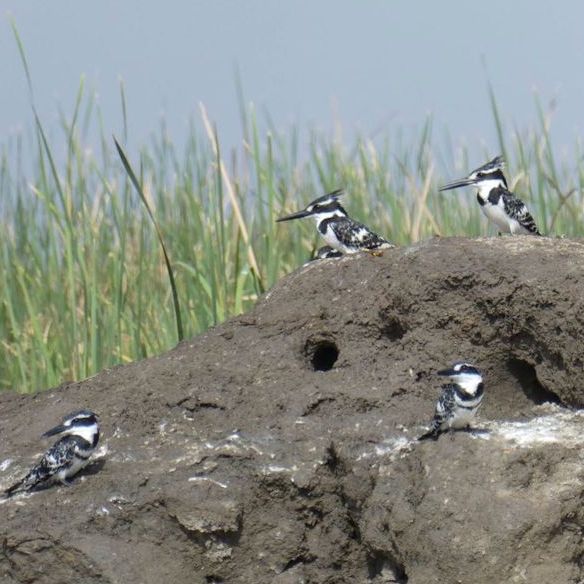 |
| Pied kingfishers were everywhere in the #Mesopotamian marshes of #iraq. They live in little holes in the cement-like mud banks. Click to enlarge. |
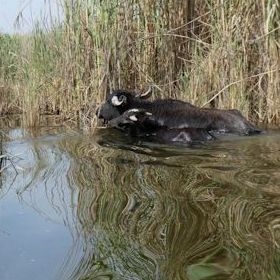 |
| Water buffalo in the Mesopotamian marshes of Iraq. Marsh dwellers raise them for milk, cheese and cream. The buffalo often live in part of people’s reed houses and are as docile as dogs. Click to enlarge. |
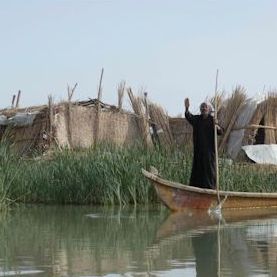 |
| Marsh dwellers make their houses from the Phragmites reeds, just as the ancient Sumerians did before them. Click to enlarge. |
“Some people live on floating islands
constructed of cut reeds
built up over generations. . .
They build little ovens from the
sticky mud that hardens like concrete
and burn buffalo ‘patties’ for fuel to bake their bread. . .
In the 1990s Saddam Hussein retaliated against rebels
hiding out in the labyrinthine marshes
by ordering levees built to drain the wetlands. . .
But when the United States invaded, locals came back and
broke open the levees to restore the marshes.”
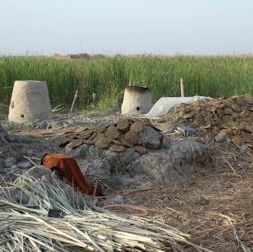 |
|
Marsh dwellers form their buffaloes’ droppings into little patties, which they dry in the sun to use for fuel in ovens made of clay. The land in the foreground is actually atop water, made of cut reeds by generations of people. Walking on it is a bit bouncy, kind of like tundra. Click to enlarge. |
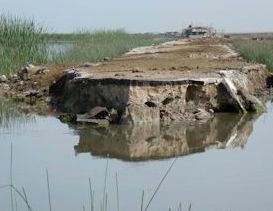 |
|
Levee break. In the 1990s Saddam Hussein ordered that the Mesopotamian marshes be drained, because rebels were hiding in the 20-foot-tall reeds and Byzantine waterways. This levee was part of that effort, which ultimately reduced the mighty marshes by 90 percent. After his fall, locals, who’d had to move off the water for 10 years or more, came back and busted open the levees. Wetlands experts helped in the restoration. But now climate change and upstream dams in Turkey and Iran threaten water supplies to the marshes. Click to enlarge. |
The remaining images present a natural history
of how the marsh dwellers of Iraq
utilize their most ubiquitous natural resource,
the Phragmites australis reeds, which they transform
from wild marsh plants into
significant architectural structures.
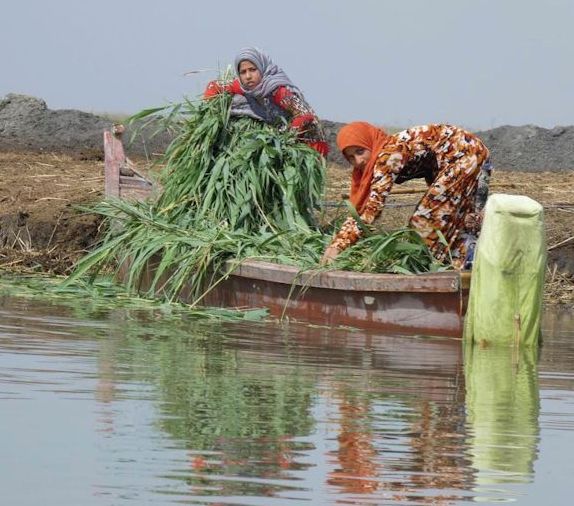 |
| Marsh dwellers spend a lot of time harvesting and processing the Phragmites reeds, the dominant, fast-growing, renewable resource of the marshes. Click to enlarge. |
 |
| Woman heading home at dusk with a full load of reeds. Click to enlarge. |
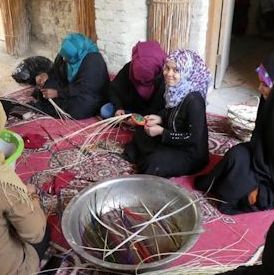 |
| Women learning to weave grasses. Click to enlarge. |
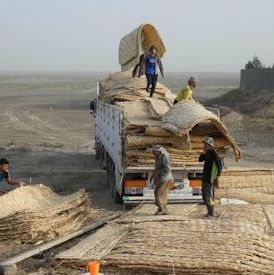 |
| Men loading woven mats made from the marshes’ dominant Phragmites reeds. They ship them all over the Middle East to be used as floor mats, roofs or walls. Click to enlarge. |
 |
| This same basic structure of reed homes (minus the plastic tarp) has been built in the Mesopotamian marshes since the time of the ancient Sumerians, 6,000 years ago. Click to enlarge. |
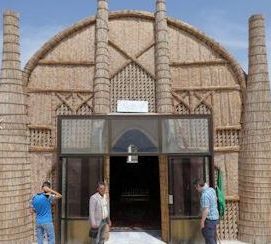 |
| The exterior of a Mudhif in Chibayish, Iraq. A Mudhif is a community gathering place that's a larger, fancier version of the marsh home structure built entirely of Phragmites reeds, but with a life span of only about ten years. Click to enlarge. |
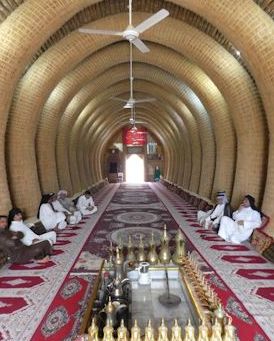 |
| Frequented primarily by men, the interior of the Mudhif in Chibayish welcomes visitors with small portions of strong coffee, and also serves as a venue for adjudicating disputes. Its thick, high ceiling keeps temperatures inside comfortable on hot days. Shoes are left at the door. Click to enlarge. |
* From the weekly news magazine SEJournal Online, Vol. 3, No. 40. Content from each new issue of SEJournal Online is available to the public via the SEJournal Online main page. Subscribe to the e-newsletter here. And see past issues of the SEJournal archived here.














 Advertisement
Advertisement 



